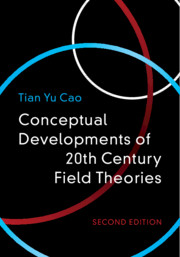Book contents
- Conceptual Developments of 20th Century Field Theories
- Reviews of the first edition
- Conceptual Developments of 20th Century Field Theories
- Copyright page
- Dedication
- Contents
- Preface to the Revised Edition
- Preface to the First Edition
- 1 Introduction
- 2 The Rise of Classical Field Theory
- Part I The Geometrical Programme for Fundamental Interactions
- 3 Einstein’s Route to the Gravitational Field
- 4 The General Theory of Relativity
- 5 The Geometrical Programme
- Part II The Quantum Field Programme for Fundamental Interactions
- Part III The Gauge Field Programme for Fundamental Interactions
- Appendices
- References
- Name Index
- Subject Index
4 - The General Theory of Relativity
from Part I - The Geometrical Programme for Fundamental Interactions
Published online by Cambridge University Press: 01 October 2019
- Conceptual Developments of 20th Century Field Theories
- Reviews of the first edition
- Conceptual Developments of 20th Century Field Theories
- Copyright page
- Dedication
- Contents
- Preface to the Revised Edition
- Preface to the First Edition
- 1 Introduction
- 2 The Rise of Classical Field Theory
- Part I The Geometrical Programme for Fundamental Interactions
- 3 Einstein’s Route to the Gravitational Field
- 4 The General Theory of Relativity
- 5 The Geometrical Programme
- Part II The Quantum Field Programme for Fundamental Interactions
- Part III The Gauge Field Programme for Fundamental Interactions
- Appendices
- References
- Name Index
- Subject Index
Summary
In comparison with STR, which is a static theory of the kinematic structures of Minkowskian spacetime, general theory of relativity (GTR) as a dynamical theory of the geometrical structures of spacetime is essentially a theory of gravitational fields. The first step in the transition from STR to GTR, as we discussed in Section 3.4, was the formulation of EP, through which the inertial structures of the relative spaces of the uniformly accelerated frames of reference can be represented by static homogeneous gravitational fields. The next step was to apply the idea of EP to uniformly rotating rigid systems. Then Einstein (1912a) found that the presence of the resulting stationary gravitational fields invalidated the Euclidean geometry. In a manner characteristic of his style of theorizing, Einstein (with Grossmann, 1913) immediately generalized this result and concluded that the presence of a gravitational field generally required a non-Euclidean geometry and that the gravitational field could be mathematically described by a four-dimensional Riemannian metric tensor gμv (Section 4.1). With the discovery of the generally covariant field equations satisfied by gμv, Einstein (1915a–d) completed his formulation of GTR.
- Type
- Chapter
- Information
- Conceptual Developments of 20th Century Field Theories , pp. 56 - 77Publisher: Cambridge University PressPrint publication year: 2019



